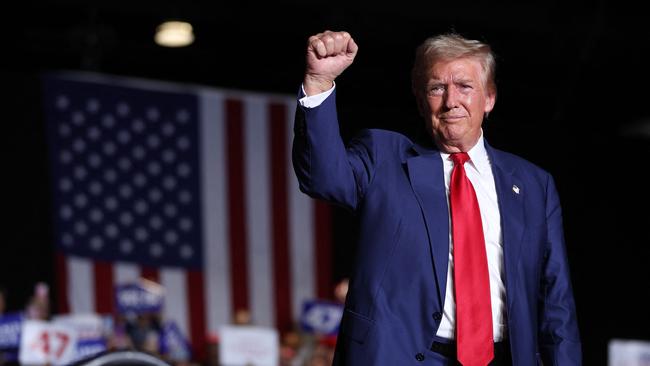Kamala Harris or Donald Trump, America’s presidential election is sweet music for stockmarkets

Investors worldwide fear the worst. But there is good news: Stocks probably won’t suffer in the drama.
Falling election uncertainty should power global stocks through the year, lifting the ASX 200, too.
In January, I showed you that US election years boost stocks. America’s S&P 500 rose in 83 per cent of them since 1925, averaging 11.4 per cent gains in US dollar terms.
This bullish force extends globally: US stocks’ correlation to developed markets elsewhere is 0.83 – strong, considering 1.00 means identical movement and minus 1 is the exact opposite.
US stocks’ correlation with the ASX is slightly weaker, at 0.68, but still strong.
Sector differences affect magnitudes, but on direction, Australia and America are mostly aligned. So it is thus far in 2024, with US stocks up 14.5 per cent through September 6, while the ASX rose 8.4 per cent. More awaits.
This election has history-making twists. It feels wild. Beyond the events, the candidates’ personalities and colourful sound bites – often unflattering – steal the spotlight.
But stocks look past this, focusing on what counts: Uncertainty, higher now, will fall. There will be a winner emerging soon, and markets will rally around that.
This is a strong tailwind. Stocks hate question marks. They rattle nerves, discouraging risk-taking.
Early in most US election years, unknowns abound. Myriad candidates typically clog the party primary races. They play to their bases – extreme fringes – touting extreme views.
Hence, elevated uncertainty usually stalls markets early in election years, when US returns average just 2.8 per cent in the first half, since 1925.
But in the typical second half, uncertainty melts. Stocks love that. Rowdy party primary races bring nominees. Then come running mates. Party conventions reveal policy platforms. Rhetoric moderates as both sides court centrist independents. State polls illuminate each candidate’s paths to victory.

Meanwhile, with congress busy campaigning, all legislation stops. So markets needn’t fret about sudden policy disruptions.
They love it! The S&P 500 averages 9.2 per cent in US election years’ second halves. Fun fact: This includes 16 years with positive first halves. Of these, the second half rose all but once (1948).
We got that positive first half this year, amid unusually low early uncertainty. A Joe Biden-Donald Trump rematch looked destined. Two exceptionally well-known candidates. Absent scary primary noise, stocks shined worldwide. But then Biden’s late-June debate stumble amped up fears over his electability. The assassination attempt on Trump followed.
Then Biden’s exit and Vice-President Kamala Harris’s grand entrance – along with questions about her potential platform. Early rumblings about Harris’s viability stoked talk of August’s party convention becoming a multi-candidate cage match. Uncertainty rose.
But it fades fast now. Harris quickly attracted endorsements and donors, secured the nomination and picked her running mate. Her policy platform is taking shape. Clarity is coming.
Polls wiggled Harris’s way prior to September’s debate (it isn’t clear how or if this has a lasting effect). But it is close and still early. Things could shift.
Regardless, the two candidates’ paths to victory are coalescing.
America isn’t a direct democracy. The Electoral College determines the outcome, casting population-weighted votes based on winner-take-all state-level results. Only seven of 50 states seriously look up for grabs. The true swing states are Arizona, Georgia, Michigan, Nevada, North Carolina, Pennsylvania and Wisconsin.
They will decide the victor.
Harris seems to have a baseline of 226 electoral votes versus 219 for Trump. The winner needs 270.
Polling in all seven swing states is tight. Both candidates have numerous paths to victory. But the roads will narrow – soon.
A winner will emerge. So will congress’s structure, foretelling how much US legislative risk could lurk in 2025.
The clarity will help stocks higher through the year – in America, Australia and beyond.
But what might Harris do on taxes? Regulation?
Would Trump fully politicise the US Federal Reserve? Touch off more tariff tiffs? Slow down.
It is a mistake to overrate any president’s power to act unilaterally. America’s 2025 global political impact hinges on the whole government’s make-up – including both chambers of congress.
If America’s golden gridlock continues, squashing market-menacing bills, stocks should thrive. If not, risks may emerge. This election determines that and both chambers are hugely too close to call now. But here, too, clarity is coming. Soon.
Of course, Australia’s next election also awaits. But that is all for 2025. For now, relax and enjoy late 2024’s falling uncertainty, whose tailwinds should lift stocks worldwide.
Diversify globally to work around Australia’s value tilt and relative lack of growth stocks. Benefit as the US election proves a rising tide lifting most boats.
Ken Fisher is executive chairman of Fisher Investments.





Another assassination attempt, late candidate swap, campaign hacking, flip-flopping polls – what more wackiness can the US election yield?